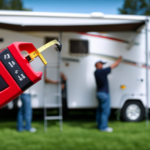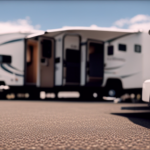If you need new struts for your camper shell, it is crucial to accurately measure them for proper fit and optimal performance. While measuring the struts of a camper shell may seem difficult at first, with the right tools and techniques, the process can be simple.
In this article, I will guide you through the precise steps to measure your camper shell struts effectively.
To begin, we will first understand the purpose of camper shell struts and the importance of accurate measurements. Then, we will gather the necessary tools for measurement, including a measuring tape and a pen and paper.
Next, we will measure the extended length of the strut and the compressed length. Additionally, we will determine the diameter and mounting style of the struts, considering weight capacity and durability.
Once we have gathered all the measurements and specifications, we will research and compare replacement options. Finally, we will purchase the correct size and style of camper shell struts and install them, testing for proper functionality.
So, let’s dive into the detailed process of measuring your camper shell struts accurately.
Key Takeaways
- Properly measuring the extended length and compressed length of the struts is crucial for compatibility and proper installation.
- Determining the diameter and mounting style of the struts is necessary for selecting the right replacement option.
- Consider the weight capacity and durability of the struts, selecting ones that exceed the total weight of the camper shell and cargo for optimal performance and safety.
- Research and compare different replacement options based on cost, customer reviews, and compatibility before making a purchase.
Understand the Purpose of Camper Shell Struts
So, you want to understand why camper shell struts are important, huh? Well, let me tell you, these nifty little things are what keep your camper shell open and stable, making it easier for you to access your belongings and enjoy your camping experience to the fullest!
The benefits of using camper shell struts are numerous. Firstly, they provide support to the shell, preventing it from collapsing and causing potential damage to your belongings. Secondly, they allow you to keep the shell open, providing a convenient and hands-free way to load and unload your camping gear. Additionally, camper shell struts ensure that the shell remains stable even in windy conditions, preventing any accidental closures or damage.
However, there can be common issues with camper shell struts that you may encounter. If you notice that your shell is not staying open or is closing unexpectedly, it could be due to worn or damaged struts. In such cases, troubleshooting involves inspecting the struts for any visible signs of wear or damage and replacing them if necessary.
With the importance of camper shell struts in mind, let’s now move on to the next section about gathering the necessary tools for measurement.
Gather the Necessary Tools for Measurement
First, you’ll need a tape measure and a wrench to complete the task.
Did you know that properly functioning struts can increase the lifespan of your camper shell by up to 50%? Camper shell struts play a crucial role in providing support and stability to the shell, ensuring it remains securely in place and opens smoothly. By using struts, you can prevent unnecessary wear and tear on your camper shell, as well as reduce the risk of damage caused by sudden movements or heavy winds.
To measure the effectiveness of your camper shell struts, start by inspecting them for common signs of wear and tear. Look for any oil leaks, rust, or visible damage on the struts. Additionally, pay attention to how the shell opens and closes. If it feels heavy or difficult to lift, or if it slams shut on its own, these may be indicators of worn out struts.
Once you have determined that your struts need to be measured, the first step is to measure the extended length of the strut. This will help you identify any discrepancies in length compared to the manufacturer’s specifications.
Measure the Extended Length of the Strut
To accurately assess the performance of your camper shell, it’s crucial to determine the extended length of the struts. This will allow you to uncover any potential discrepancies and ensure optimal functionality.
One measuring technique that is commonly used is to fully extend the strut and measure from the center of one mounting point to the center of the other. This will give you the accurate extended length of the strut.
It’s important to note that when measuring, you should avoid common mistakes such as measuring from the end of the mounting points or including any additional components that may affect the length. By following this measuring technique and avoiding these common mistakes, you can ensure accurate measurements of the extended length of the strut.
Now, let’s move on to the next step, which is measuring the compressed length of the strut.
Measure the Compressed Length of the Strut
Now, let’s find out the compressed length of the strut to complete the assessment of your camper shell’s performance.
To measure the compressed length accurately, follow these steps:
-
Start by fully compressing the strut. Ensure that both ends of the strut are pushed together as tightly as possible.
-
Use a measuring tape to measure the distance between the mounting points of the strut. This measurement will give you the compressed length of the strut.
-
Make sure to take the measurement multiple times to ensure accuracy. If there’s any variation in the measurements, take the average value for a more precise result.
By measuring the compressed length of the strut, you’ll have a better understanding of its sizing and performance. This measurement is crucial when determining the appropriate replacement strut or when upgrading to a different style or size. With this information, you can proceed to the next step of the assessment, which is determining the diameter and mounting style of the strut.
Transitioning into the subsequent section on determining the diameter and mounting style, we can now move on to understanding the specific requirements for your camper shell.
Determine the Diameter and Mounting Style
Are you curious about the specific requirements for your camper shell in terms of the diameter and mounting style of the struts? Determining the diameter and mounting style of your camper shell struts is crucial to ensure compatibility and proper installation. To determine the diameter, you will need to measure the width of the mounting brackets or the diameter of the existing struts. This measurement will help you identify the appropriate diameter for the new struts.
Next, you need to identify the mounting location for the struts. This can be determined by examining the camper shell and locating the mounting points or brackets. It is important to note that different camper shell models may have different mounting styles, such as ball socket or stud mount. You will need to determine the specific mounting style of your camper shell to ensure the struts are compatible.
To help visualize these requirements, refer to the table below:
| Mounting Style | Description |
|---|---|
| Ball Socket | Struts with a rounded ball at one end that fits into a socket |
| Stud Mount | Struts with a threaded stud at one end that screws into a mounting bracket |
Once you have determined the diameter and mounting style of your camper shell struts, you can proceed to the next step and check for any specific brand or model requirements. This will ensure that you select the correct struts for your camper shell.
Check for Any Specific Brand or Model Requirements
Make sure to check if there are any specific brand or model requirements for your camper shell, as this will ensure you select the correct struts for your setup. When it comes to measuring camper shell struts, different measurement techniques may be required depending on the specific brand requirements.
Here are three important sub-lists to consider:
-
Mounting Style:
- Determine if your camper shell requires gas-filled struts or mechanical ones.
- Check if the struts need to be top-mounted or side-mounted.
- Verify if any additional brackets or hardware are needed for installation.
-
Length and Diameter:
- Measure the length of the existing struts from end to end.
- Note down the diameter of the strut cylinder.
- Consult the manufacturer’s guidelines for any specific length or diameter requirements.
-
Weight Capacity and Durability:
- Consider the weight capacity of the struts based on the weight of your camper shell.
- Ensure the struts are durable enough to withstand constant use and external conditions.
- Look for struts made from high-quality materials like stainless steel or aluminum for longevity.
Now that you have determined any specific brand or model requirements and have measured the struts accurately, you can move on to considering the weight capacity and durability of the struts for your camper shell setup.
Consider Weight Capacity and Durability
After checking for any specific brand or model requirements, it’s important to consider weight capacity and durability when measuring camper shell struts.
These factors play a crucial role in ensuring the struts can effectively support the weight of the camper shell and withstand the rigors of regular use.
When it comes to weight capacity considerations, it’s essential to determine the maximum weight that the struts need to support. This includes not only the weight of the camper shell itself but also any additional cargo that may be stored on top. Choosing struts with a weight capacity that exceeds the total weight is recommended to ensure optimal performance and safety.
Durability factors should also be taken into account. Camper shell struts are exposed to various environmental conditions, such as heat, cold, rain, and UV radiation. Therefore, selecting struts made from high-quality materials that are resistant to corrosion and can withstand these elements is crucial for long-lasting performance.
When measuring camper shell struts, it’s vital to consider weight capacity considerations and durability factors. By taking these factors into account, you can ensure that the struts will provide the necessary support and withstand the test of time.
Moving forward, let’s delve into how to research and compare replacement options.
Research and Compare Replacement Options
To find the best replacement options, you should start researching and comparing different strut models, like a detective examining clues to solve a mystery.
There are several factors to consider when comparing replacement options for camper shell struts.
Firstly, cost comparison of different replacement options is crucial. Look for struts that are within your budget while still maintaining good quality and durability. Keep in mind that cheaper options may not last as long or provide the same level of support as more expensive ones.
Secondly, customer reviews and satisfaction ratings of different replacement options are valuable sources of information. Read what other camper shell owners have to say about their experiences with different struts. Pay attention to feedback on durability, ease of installation, and overall performance.
Lastly, consider the specific requirements of your camper shell. Ensure that the replacement struts are compatible with your camper shell’s weight capacity and design. Taking accurate measurements and consulting the manufacturer’s specifications will help you purchase the correct size and style of camper shell struts.
By thoroughly researching and comparing different replacement options based on cost, customer reviews, and compatibility, you can make an informed decision.
Now, let’s move on to the next section about purchasing the correct size and style of camper shell struts.
Purchase the Correct Size and Style of Camper Shell Struts
Finding the perfect fit for your camper shell’s support system is essential if you want to ensure a smooth and hassle-free installation experience. When purchasing camper shell struts, there are a few factors to consider: choosing between gas or hydraulic struts and understanding the different mounting options available.
Gas struts provide a reliable and consistent level of support for your camper shell. They are filled with compressed gas, which allows for smooth and controlled movement when opening and closing the shell. On the other hand, hydraulic struts use fluid to provide support. They are known for their durability and ability to handle heavy loads.
In terms of mounting options, there are typically two choices: ball socket and bracket mounting. Ball socket mounting involves attaching the strut to a ball stud on both the camper shell and the vehicle. This option allows for easy installation and provides a secure connection. Bracket mounting, on the other hand, involves attaching the strut to a bracket on both the shell and the vehicle. It offers a sturdy and reliable support system.
By carefully considering whether gas or hydraulic struts are the right choice for your camper shell and understanding the different mounting options available, you can ensure that you purchase the correct size and style of struts. With the right struts in hand, you can move on to the next step of installing them and testing for proper functionality.
Install the New Struts and Test for Proper Functionality
After purchasing the correct size and style of camper shell struts, it’s time to install them and test for proper functionality.
To begin, make sure you have all the necessary tools and equipment on hand. Start by removing the old struts one at a time, taking note of how they are attached. Then, attach the new struts using the same method, ensuring they’re securely in place.
Once the new struts are installed, it’s crucial to test for leaks and check for a proper seal. This can be done by closing and locking the camper shell and observing any signs of air or water entering the shell. Pay close attention to the areas around the struts and seals, as these are common areas for leaks to occur. If any leaks or improper seals are detected, adjustments may be needed to ensure a tight fit.
To engage the audience further, here are three sub-lists to consider:
Tips for installing camper shell struts:
- Use caution when removing the old struts to avoid injury.
- Follow the manufacturer’s instructions for proper installation.
- Double-check the alignment of the struts before securing them.
Signs of leaks or improper seals:
- Air or water entering the camper shell when closed.
- Visible gaps between the shell and the bed of the truck.
- Excessive noise or movement while driving.
Adjustments for a proper seal:
- Tighten any loose bolts or screws.
- Apply sealant or weatherstripping to problem areas.
- Consider professional assistance if the issue persists.
By following these steps and thoroughly testing for leaks and proper sealing, you can ensure that your camper shell struts are functioning correctly and providing the necessary support for your shell.
Frequently Asked Questions
How do camper shell struts work?
Back in the day, camper shell struts were like the rockstars of the camping world. Now, let me break it down for you.
Gas struts, which are commonly used in camper shell struts, work by using compressed gas to provide the force needed to lift and hold the shell open. They have a piston and cylinder design, with a valve controlling the flow of gas.
However, common problems can include leaking gas, loss of pressure, or even complete failure.
Can I use any type of measuring tape to measure the extended length of the strut?
Yes, any type of measuring tape can be used to accurately measure the extended length of the strut. To do this, extend the strut fully and secure it in place. Then, position the measuring tape at one end of the strut and measure along the length until you reach the other end. Ensure that the tape is straight and taut for the most accurate measurement. Record this measurement to determine the strut length.
Are there any specific tools required to measure the compressed length of the strut?
To obtain accurate measurements for the compressed length of the strut, specific tools are required. A caliper is an ideal tool for this task as it allows for precise measurements. By using a caliper, one can easily measure the compressed length of the strut, ensuring accuracy in the measurement process. This tool is essential in obtaining precise measurements, which are crucial when working with camper shell struts.
What are the different types of mounting styles for camper shell struts?
There are several different types of mounting styles for camper shell struts. The most common types include ball socket, double-ended, and pin-style mounts. Each mounting style has its own pros and cons.
Ball socket mounts offer a wide range of motion and flexibility, but may require additional hardware for installation.
Double-ended mounts provide a secure attachment on both ends, but may limit adjustability.
Pin-style mounts are easy to install and adjust, but may not be as durable as other options.
How do I determine the weight capacity and durability of camper shell struts?
When it comes to choosing the right size camper shell struts, it’s important to consider several factors.
Firstly, determine the weight capacity required based on the weight of your camper shell. This can be calculated by measuring the weight of the shell itself and any additional weight it’ll carry.
Secondly, consider the durability of the struts by examining their construction material, such as stainless steel or aluminum, and checking for features like corrosion resistance and load-bearing capabilities.
What size camper shell struts would be recommended for towing a pop-up camper with an SUV?
When towing a pop-up camper with an SUV, it is important to use the best suvs for towing. To ensure smooth operation, the recommended size for camper shell struts would be ones specifically designed for your pop-up camper and SUV combination. It’s crucial to choose the right size for safety and efficiency.
Can I Use Camper Shell Struts for Flex Sealing the Roof?
If you’re wondering how to seal camper roof, using camper shell struts for flex sealing the roof can be an effective solution. These struts provide support and reinforcement, helping to prevent leaks and keep your camper roof watertight. Make sure to choose high-quality struts and follow proper installation instructions for best results.
Conclusion
In conclusion, measuring camper shell struts is a crucial step in ensuring the proper functioning and durability of your camper shell. By understanding the purpose of the struts and gathering the necessary tools, you can accurately measure the extended and compressed lengths, as well as determine the diameter and mounting style.
Considering weight capacity and durability is essential in selecting the right replacement options. For example, imagine you’re on a camping trip and your camper shell struts fail to hold up the shell, resulting in damage to your camping equipment and a disrupted trip. That’s why it’s important to measure and replace the struts correctly to avoid such situations.



















